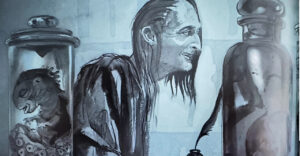Today we’re discussing episode 2.02 of The Handmaid’s Tale: Unwomen. There’s a difference between just plain old “world-building” and giving a real sense of texture to the world your show inhabits. Oh, and being absolutely terrifying while doing it…
“You are not married. It is forbidden.”
Wow. There have been a lot of heavy, scary, and downright horrifying moments on The Handmaid’s Tale. But, this takes the cake. Hell, it eats the cake.
I have never been so appalled, scared, and shaken by a scene in television in recent memory. But we’ll get there in a bit – we’ve got a lot to cover.
Unwomen, a loving term bestowed upon women who can neither serve the purpose of giving birth, being married to a man, or working as a Martha, are sent to the colonies – which are, indeed, a real place. That is where we find Rory Ofglen Ofsteve Emily toiling away after her slight indiscretion of turning the head of an “Eye” into uncooked meatloaf whilst running him over with his own car.
Make no mistake, the colonies are no joke, and it’s obvious that people are just sent there to die. We don’t know the particulars of why the colonies are in the current condition they are in, or, even where they are in the former United States. We don’t know why the Unwomen are digging, what they are digging for, or, how it ultimately serves Gilead in the first place by being there. I suppose we’ll never find any of this stuff out, mainly because it would either require it’s own flashback, or some heavy exposition. But I truly suspect we won’t ever know the purpose of The Colonies specifically because it just doesn’t matter.
Women dig, suffer, and die. That’s the long and short of it. And, really, that’s all that matters. It’s a living embodiment of hell for those who deserve it in the eyes of Gilead, and thereby, the Lord.
Sure Marissa Tomei makes an appearance as a disgraced wife that’s all well and good (which seems to me like an affectation of The Handmaid’s Tale growing massively popular in both the fan and critic’s eyes). She even meets her maker in a fitting way – death by poison and hanging on a cross – the symbol of a God she tried so hard(?) to abide(?). And, yes, the colonies look barren, terrifying, and plain awful. But, it’s not the most trying part of this episode for me.
That honor is granted to the scene of Emily and her wife at the airport as they are trying to escape the oncoming onslaught of Gilead. It was saddening to see Emily walk away from her child and wife at the escalator as they head to Canada, but watching an ICE agent tell her that her marriage certificate was invalid was the most emotionally affecting part of this episode for me.
In one fell swoop, because a bunch of guys will it into existence, a law can appear from the heavens and totally invalidate a person’s life.
Think of how much time and energy that one puts into a marriage and, especially, the process of making it work. It’s bigger than you, bigger than me, and bigger than some law. It even feels stupid to require a document that justifies it’s being, but it’s the world we live in. So, when you go through the process, have a baby, a document to prove your married, and work hard at fulfilling that marriage only to have some guy tell you, nope, you’re not married “it’s forbidden.” I just can’t even get my head around it.
It serves as an example of how quickly this world can turn on anyone – and the fine balance that is required of the social contract by which we all live.
This is all to say, the world building on display here is phenomenal. We are left wanting more of The Colonies, how Gilead came into existence, and even more backstory from a character we thought was good and gone from our story.
The world building, however, does not stop with just Emily, her job as a professor, the colonies, or how her family was torn asunder. In fact, we are treated to a haunting set of sequences back in Boston at The Boston Globe of all places.
June is totally on her own, but does get the occasional visit from Nick (who I still want to desperately punch in the face). That’s not that point though.
June is left to her own devices while she explores the building that symbolizes free speech in MA, and we see an entire story play out right in front of us.
Good shows have a great story and the tell you about it via voiceover, character dialogue, or exposition. GREAT shows have a great story, and they SHOW it to you, and that is exactly what THM does here.
While we walk around with our recently freed headline character, we see the kind of treatment all the workers received right before the war was sparked. Like Chernobyl, the Globe seems to be a place frozen in time – papers strewn about, references to Boston sports, abandoned shoes, and even headlines on the latest newspaper that read, ” “The Aftermath … America’s Bloodiest …”.
It’s telling us that whatever happened at the Globe happened quick, and it happened soon after whatever attack took place on DC. But like all good stories, we’re start and end with a great book end – and that is the shoe.
Mike Barker directed this episode, and it was a major frakking flex on his part. We are treated to some great tension as June wields a hammer throughout the stacks of the silent Globe, and the joy of knowing it was Nick who was approaching. But, the coup de gras of the June’s timeline is the reveal of the mass execution in the basement.
Whether it was the hanging nooses, dried blood on the walls, bullet holes where people once stood, or, even the matching high heel June found in the offices above, Barker gives us all an insight into, once again, how quickly the world can change when a couple of dudes just will it into existence.
Barker, though, doesn’t come out of the gate swinging like anyone would be rightfully tempted to do. When June sees the spot of death, Barker stays on Elizabeth Moss’s extraordinarily expressive face, and we get a smooth and painfully slow reveal of the truth behind June’s sickened face. In my opinion, despite how brutal it was – this is one of the most beautifully crafted scenes in the history of The Handmaid’s Tale.
There’s plenty of more that happens in this episode, and it’s all important, but it’s the marriage sequence with Emily, and June’s discovery of mass execution that make this episode worthy of remark. Because it’s one thing to provide world-building and giving a sense of how big the world is both literally and figuratively. But, it’s a completely other thing to give that big world actual texture, and make it feel like it’s truly a part of ours. These are formative events for our characters that actively alter the plot, provide history, and help inform why our characters make the choices they do.
So, once again, I am all in on The Handmaid’s Tale. It continues an already excellent run, and it seems like it is not going down the route of The Hunger Games. What else could a guy ask for?
Mary & Blake Certified: A
Click here for all of our coverage of The Handmaid’s Tale












